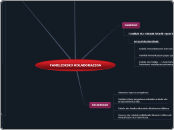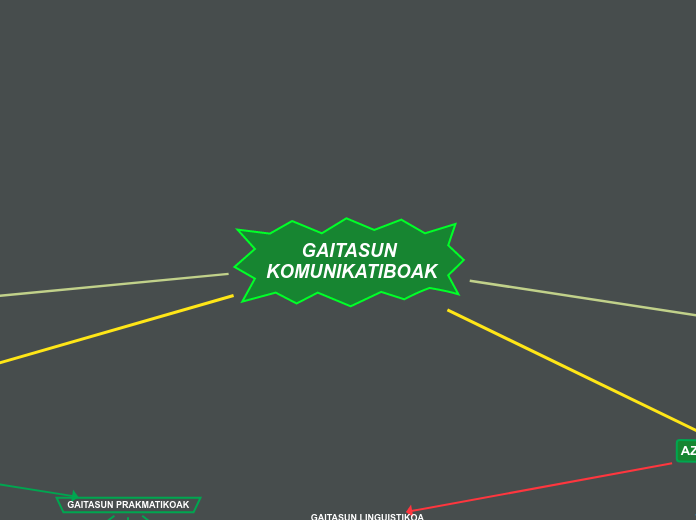ZIENTZIAK DIZIPLINAK
Psikolingustika eta kognizio zientziak
Erretorika
Soziolingustika
Testu hizkuntzaritza
Pragmatika linguistikoa
ONDO HITZ EGITEA (BRIZ)
5 OINARRI
Hizkuntza modu estrategikoak erabili
Erlazio interpertsonalak sortu eta mantendu
Komunikazioa izan
Irudia kontrolatu
Giro egokia
Publikoarekin kontaktua
Diskurtsoa ondo helarazi
Ideia argiak
Orden logikoa
Komunikazioa testuingurura moldatu
Entzuleari egokitu
Erregistroa hautatu
Hizkuntzaren erabilera
Arau gramatikalak errespetatu
Edozein entzule edo entzule-talderen aurrean diskurtso bat prestatzen eta gauzatzen jakitea da.
Hiztun batek testuinguru soziokultural desberdinetan eraginkor batean komunikatzeko gaitasuna (Hymes 1967)
ZER DA?
GAITASUN KOMUNIKATIBOA
Type in the name of the multiple-perspectives text.
Example: Bridge to Terabithia by Katherine Paterson
IRAKASLEEN GAITASUN KOMUNIKATIBOA
C1 maila izan behar dute
HIRU EREMUTAN
Irakasle/familiak edota tutoreak
Irakasle/ikasle
Irakasle/irakasle edota beste profesionalak
HELBURU NAGUSIA
Alde afektiboa bultzatzea eta erregulatzea
Informatzea
Dinamizatzailea izatea
Ikasleak haien kabuz hausnartzea
EUROPAKO ERREFERENTZIA MARKO BATERATUAREN SAILKAPENA
GAITASUN PRAGMATIKOA
GAITASUN FUNTZIONALA
Elkarreraginezko eskemak
Makrofuntzioak
Mikrofuntzioak
Diskurtso antolatzeko eta kontrolatzeko ahalmena.
DISKURTSO GAITASUNA
OSAGAIAK
Koherentzia eta kohesioa
Gaiaren garapena
Hitz egiteko txanda
Malgutasuna (Egoeraren arabera)
Esaldien antolakuntza
Testuaren plana
Alderdien kontrola (mintzagaia, informazio berria, "berezko" katetzea, ondorioa)
Adeitasun-arauak
Erregistro-desberdintasuna
Dialektoa eta azentua
Herri-jakintzaren adierazpenak
Gizarte-harremanen adierazle linguistikoa
AZPIGAITASUNAK
CANALE ETA SWINEN SAILKAPENA
Identify an important issue from the text that is being presented from different angles. Type it in.
Example: Jesse's drawing talent.
GAITASUN ESTRATEGIKOA
Komunikazioan gertatzen diren gabeziei aurre egiteko erabiltzen diren estrategiak dira.
HITZEZKOAK
Birformulazioak
Sinonimoak
Mimika
EZ HITZEZKOAK
Begirada
Espazioaren kudeaketa
Gorputzaren jarrera
Artefaktoen erabilera
ERAGINKORTASUNA
Ikus-entzunezkoen erabilpena
Diskurtsoari oxigenoa eman, atalen artean eten txikiak eginez
Ahotsaren intentsitatea espaziora egokitu
Entzulei begiratzea
Gidoiak eta eskemak erabiltzea
DISKURTSO-GAITASUNA
Whose character does the third point of view belong to?
Type in his/her name.
Example: Mr. Aarons, Jesse's father.
METODO DESBERDINAK
Aristotelesek aipatutako metodoa
What kind of narration introduces the viewpoint?
Choose an answer:
First person point of view - using the personal pronouns 'I' or 'we'Second person point of view - using the personal pronoun 'you'Third person point of view - using the third-person pronouns 'he', 'she' and 'they'Omniscient point of view - an all-seeing observer tells the story
5. Actio
4- Memoria
3- Elocutio
2- Dispositio
1- Inventio
BI MOTA
Ahozko diskurtsoa
Diskurtso idatzia
KOHESIOA ETA KOHERENTZIA
What does the character think, say or do that suggests their perspective on the issue?
Type in a quote and try to maintain the citation format.
Example: 'He would like to show his drawings to his dad, but he didn't dare. (...) He'd thought his dad would be pleased. He wasn't. What are they teaching in that damn school? he had asked.' (Paterson, 2.8)
Baliabide erretorikoak erabiltzea
Testu antolatzaileak erabiltzea
Esandakoa ondo egituratu
Ondorioak
Garapena
Sarrera
Eskema edo gidoi bat egitea
GAITASUN SOZIOLINGUISTIKOA
Decide on the second point of view
Name the character (it can either be the main character or one of the supporting characters) whose point of view you are presenting.
Example: Miss Edmunds, Jesse's music teacher.
TESTUINGURUAREN ALDAKORTASUNA
Hiztuna aldaetara egokitu beharko
da ekintza komunikatibo
TESTUA MENDERATZEA
Testu-erregelak
EGOKITASUNA
Gizartearen balioak ezagutzen ditu
Entzuleen ezagutzera moldatu
Entzuleen interes eta beharrak kontuan hartu
Hizkuntz jarduna moldatzea gizarte horren ohituretara
Gizarte arauak errespetatzen ditu
TESTUINGURUA
Testuingurua ezagutu behar da
How is the viewpoint introduced in the story?
Choose an answer:
First person point of viewSecond person point of viewThird person point of viewOmniscient point of view
Generoa
Ekintzen sekuentzia
Egoera
Arau ezplizituak eta inplizituak
Parte hartzaileen rolak
Testua eta testuinguruaren arteko egokitasuna
Type in a quote that points out the character's position about the issue.
Try to follow a citation format: author's name, chapter, and page.
Example: 'She said he was unusually talented, and she hoped he wouldn't let anything discourage him.' (Paterson, 2. 8)
GAITASUN LINGUISTIKOA
Decide on the first point of view you are going to present.
Type in the name of the character (it can either be the main character or one of the supporting characters) whose point of view belongs to.
Example: Jesse Oliver Aarons, Jr., the main character of the novel, a fifth-grader living in a rural Southern area.
ZUZENTASUNA
Type in a relevant quote that highlights the character's point of view towards
AZPIGAITASUNAK
CANALE ETA SWINEN SAILKAPENA.
Try following a citation format: author's name, chapter, and page.
Example: 'Jesse drew the way some people drank whiskey. (...) Lord, he loved to draw. (...) When he was in first grade, he told his father that he wanted to be an artist when he grew up.' (Paterson, 2. 7)
Puntuazio-arauak
Sintaxia
Ortografia-arauak
Morfologia
Semantika
Fonologia
Lexikoa
Gramatika
What type of narration introduces the viewpoint?
Choose an answer:
First person point of view - using the personal pronouns 'I' or 'we'Second person point of view - using the personal pronoun 'you'Third person point of view - using the third-person pronouns 'he', 'she' and 'they'Omniscient point of view - an all-seeing observer tells the story









